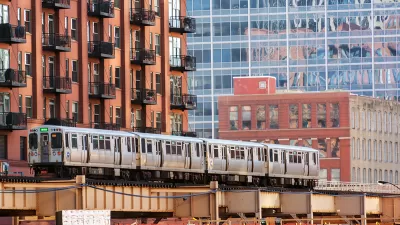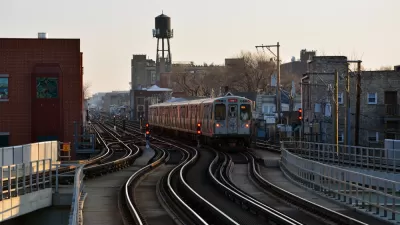After an initial proposal a year ago, prompting immediate and strong criticism, the Chicago Transit Authority has completed its environmental assessment of a proposal designed to improve service capacity at the infamous bottleneck of Clark Junction.
"The Chicago Transit Authority today issued a ringing defense of its $570 million plan to boost el capacity on crowded North Side tracks by building a huge bridge where Red, Purple and Brown line tracks now converge at Clark Street," reports Greg Hinz.
After exploring and rejecting several other alternatives, "the CTA said the plan to have northbound Brown Line tracks swing above other tracks is the best feasible alternative and will allow it to carry an additional 7,200 riders an hour through a junction that now is at capacity."
Though the environmental assessment made clear its preference for the flyover, the plan is still unfunded and expected to provoke strong opposition. The proposal requires removing 16 buildings and "plopping what amounts to a highway-like towering structure right in the middle of a residential neighborhood," according to Hinz.
The CTA Red-Purple Bypass project, as it's called, was first announced in April 2014. Architecture critic Blair Kamin produced a pointed critique of the proposal shortly after.
FULL STORY: CTA issues strong defense of Red Line flyover plan

Alabama: Trump Terminates Settlements for Black Communities Harmed By Raw Sewage
Trump deemed the landmark civil rights agreement “illegal DEI and environmental justice policy.”

Planetizen Federal Action Tracker
A weekly monitor of how Trump’s orders and actions are impacting planners and planning in America.

The 120 Year Old Tiny Home Villages That Sheltered San Francisco’s Earthquake Refugees
More than a century ago, San Francisco mobilized to house thousands of residents displaced by the 1906 earthquake. Could their strategy offer a model for the present?

In Both Crashes and Crime, Public Transportation is Far Safer than Driving
Contrary to popular assumptions, public transportation has far lower crash and crime rates than automobile travel. For safer communities, improve and encourage transit travel.

Report: Zoning Reforms Should Complement Nashville’s Ambitious Transit Plan
Without reform, restrictive zoning codes will limit the impact of the city’s planned transit expansion and could exclude some of the residents who depend on transit the most.

Judge Orders Release of Frozen IRA, IIJA Funding
The decision is a victory for environmental groups who charged that freezing funds for critical infrastructure and disaster response programs caused “real and irreparable harm” to communities.
Urban Design for Planners 1: Software Tools
This six-course series explores essential urban design concepts using open source software and equips planners with the tools they need to participate fully in the urban design process.
Planning for Universal Design
Learn the tools for implementing Universal Design in planning regulations.
Clanton & Associates, Inc.
Jessamine County Fiscal Court
Institute for Housing and Urban Development Studies (IHS)
City of Grandview
Harvard GSD Executive Education
Toledo-Lucas County Plan Commissions
Salt Lake City
NYU Wagner Graduate School of Public Service




























